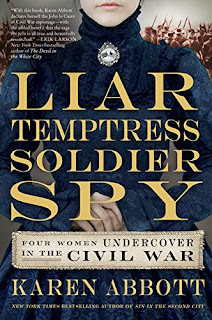By Paul Carrier
When historians examine the roles that white women played during the Civil War, they often focus on the politically prominent (such as Mary Todd Lincoln, Varina Davis and Kate Chase Sprague); the healers (Clara Barton and Dorothea Dix); the writers (Harriet Beecher Stowe and Mary Chestnut); or those who toiled on the home front in supporting roles.
Karen Abbott looks elsewhere in Liar, Temptress, Soldier, Spy, an absorbing examination of the contributions made by four women who worked undercover during the war, spying for the North in two cases and for the Confederacy in two others.
Two of the women featured here — the young, fiery Belle Boyd of Virginia and the regal, well-connected widow Rose O’Neal Greenhow of Washington — are well-known to Civil War buffs as Confederate agents. A third — the Canadian-born Emma Edmonds — disguised herself as a man. Perhaps the least-remembered of the four is Elizabeth Van Lew, a wealthy, never-married Richmond matron with Yankee roots who engaged in espionage on behalf of the Union.
“I wanted to find women who went beyond darning socks and nursing the wounded, women who lied, seduced, wheedled, plundered, spied, drank, avenged, stole and murdered their way through the war,” Abbott said in a 2014 interview with Philadelphia Weekly.
Abbott recounts the adventures of her four protagonists with a novelist’s flair for characterization and page-turning narrative, but she emphasizes in an author’s note that Liar, Temptress, Soldier, Spy is a work of nonfiction, with no invented dialogue. In fact, Boyd, Greenhow, Edmonds and Van Lew led such eventful lives that there’s no need for embellishment or fabrication.
Boyd was a courier and spy who shot a Union soldier in her home. The beautiful and imperious Greenhow seduced Union politicians to help her garner military and political intelligence for the Confederacy. Edmonds was so adept at hiding her gender that she managed to serve in the Union army without detection, and once disguised herself as a male slave, to gather intelligence. The urbane Van Lew, who ran a successful Union spy ring from her Richmond home, inserted a black agent, Mary Jane Bowser, into the very heart of the Confederacy — the Confederate White House. Van Lew hid escaped Union prisoners in a secret room in her mansion, and helped them escape to the North.
Liar, Temptress, Soldier, Spy is divided into five parts — one for each year of the war — within which alternating chapters focus on the four women in turn. Although each spy’s story is told separately, the protagonists are at least loosely linked, not only by their shared passion for espionage but also by the ripple effects of their work.
“Even if they didn’t physically interact—although my two Confederate spies, Rose Greenhow and Belle Boyd, do—it was important to me that they were running into the same people, and that there was a constant cause and effect, with one spy’s behavior influencing another spy’s situation,” Abbott said in that Philadelphia Weekly interview.
For example, Abbott explained, one of the targets of Greenhow’s espionage ring was Edmonds (aka Frank Thompson). And Union Gen. Benjamin Butler recruited Van Lew as a spy after he faced off against Boyd.
Understandably, Liar, Temptress, Soldier, Spy does not provide a comprehensive overview of the Civil War, but Abbott does place her protagonists’ activities in context. She also surrounds Boyd, Greenhow, Edmonds and Van Lew with an impressive supporting cast that includes Allan Pinkerton, George McClellan and Stonewall Jackson, among many others.
Although Liar, Temptress, Soldier, Spy is awash in derring-do, ciphers, invisible ink, and subterfuge, Abbott never loses sight of the horrors of the war. When Greenhow arrived in Richmond after one battle, Abbott writes, coffins “piled up faster than gravediggers could bury them, and the heat caused dozens of bodies to swell and burst the wood.” Another passage describes thousands of Union dead sinking into marshy ground, “waiting to be yanked up and eaten by hogs or desecrated by rebel hands.” Soldiers stuffed their nostrils with leaves “to insulate themselves from the stench” of rotting corpses.
Abbott’s protagonists may not have been saintly, or even noble. A Northern journalist who met the egotistical Boyd suggested that she belonged in an asylum, and Edmonds spent her time in the army deceiving almost everyone she met. The often-venomous Greenhow wrote that she hoped the Yankees would be “exterminated so that the vile race no longer cumber the earth.” But Liar, Temptress, Soldier, Spy leaves no doubt that all four women were strong-willed and committed to their respective causes. Above all else, they were ingenious, and remarkably brave.

